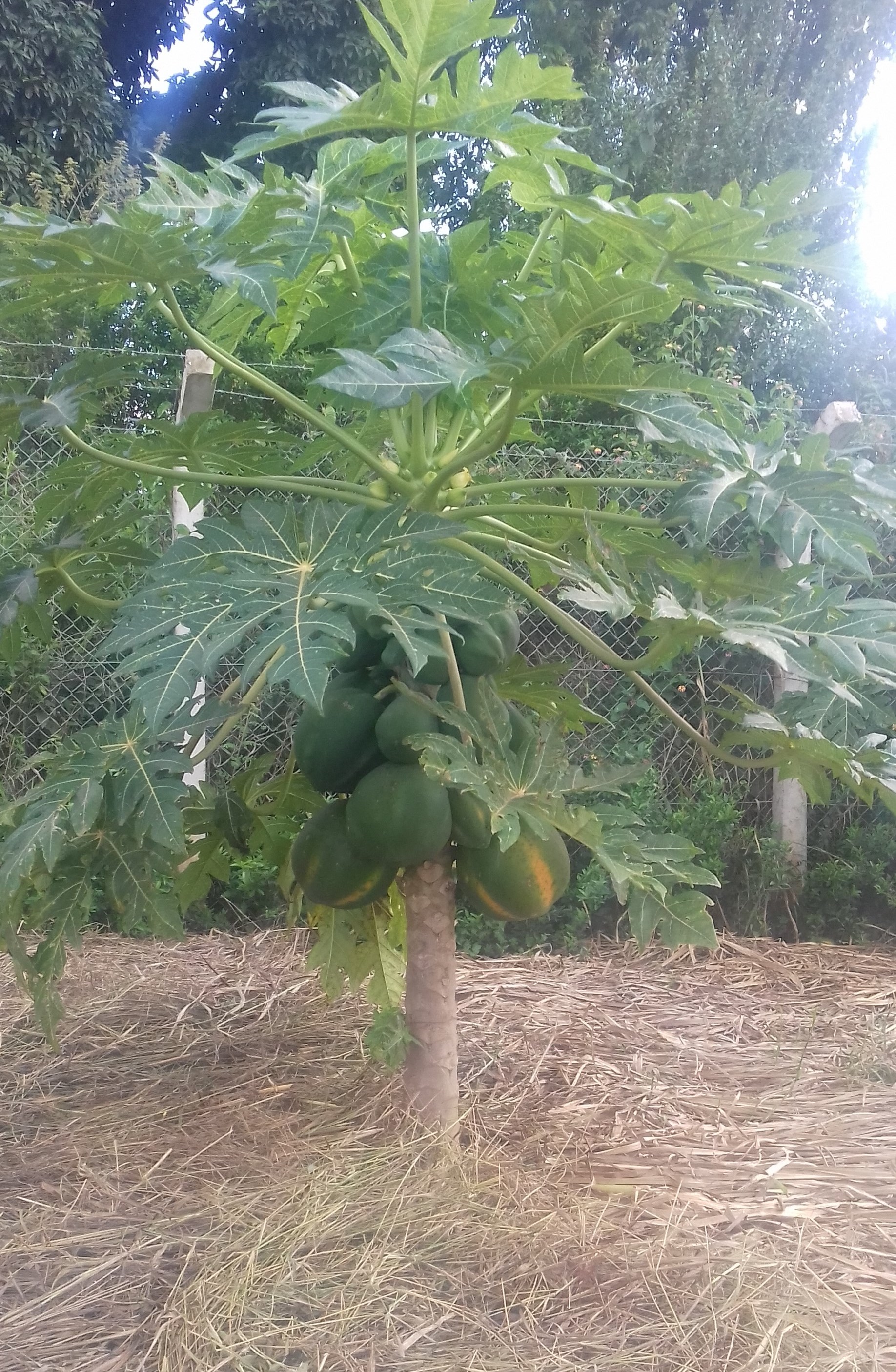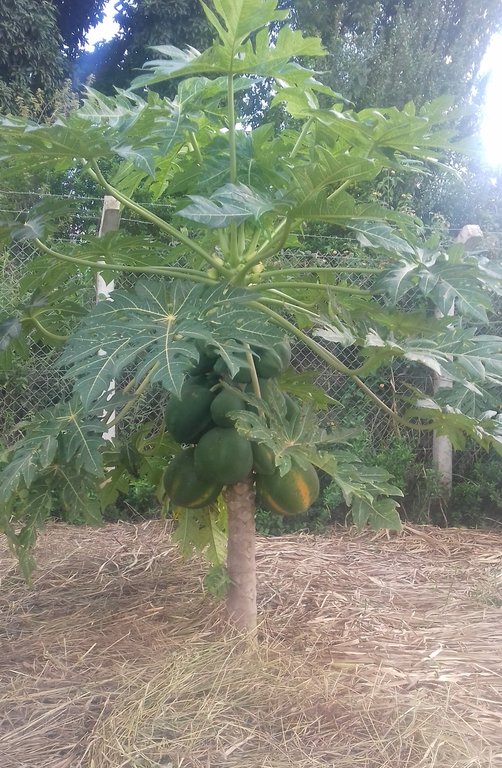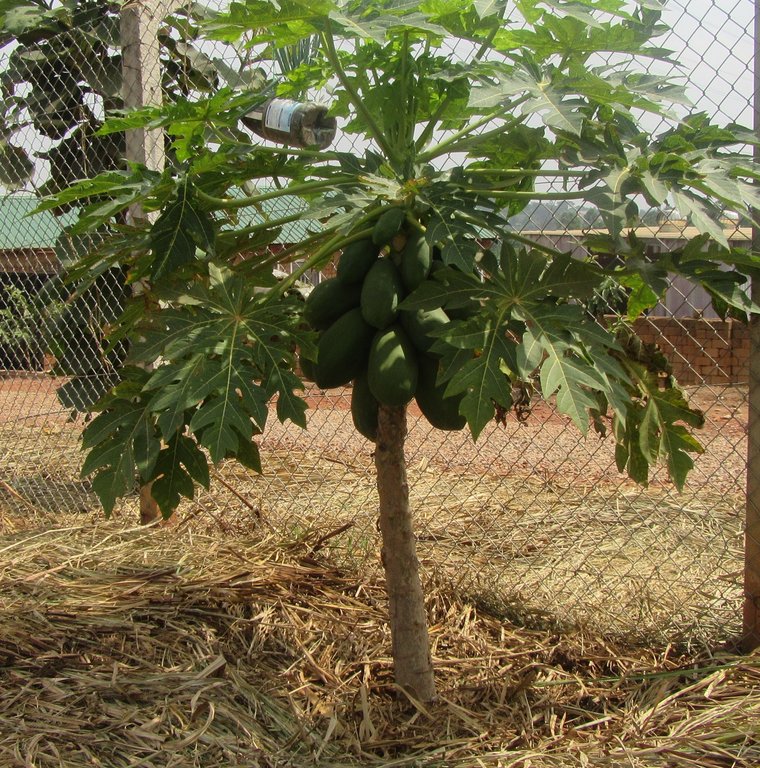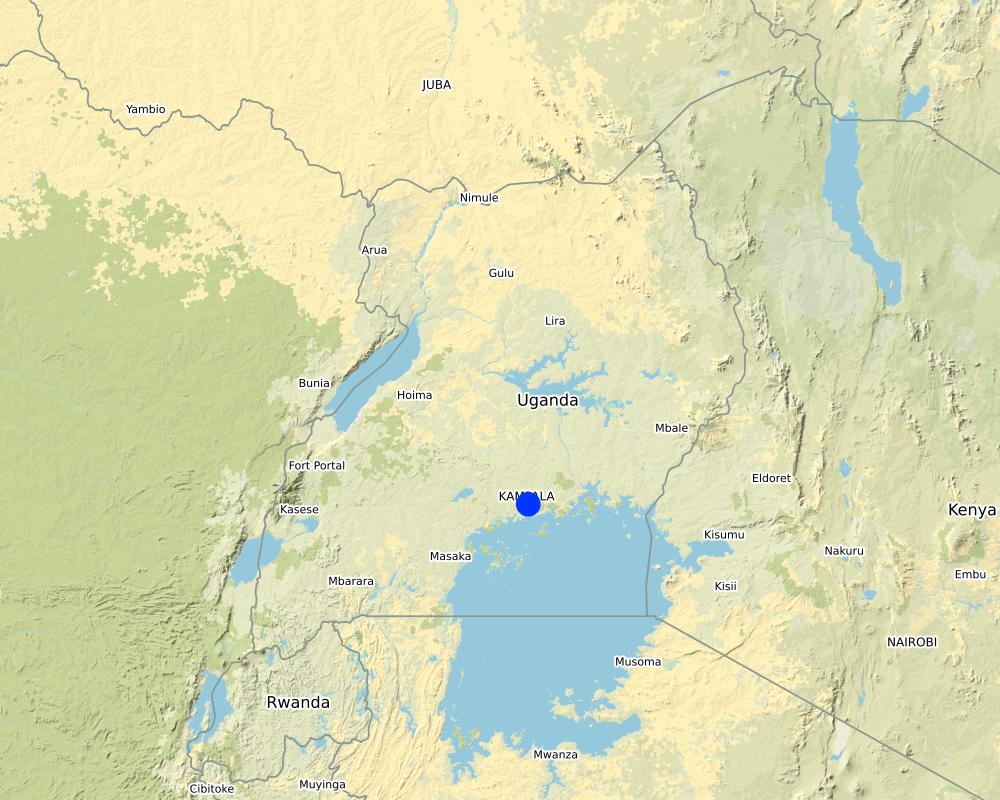Intensification of pawpaw with mulching [Uganda]
- Creation:
- Update:
- Compiler: Babirye Irene
- Editor: Kamugisha Rick Nelson
- Reviewers: Nicole Harari, Udo Höggel, Donia Mühlematter
Okulima amapapali
technologies_3461 - Uganda
View sections
Expand all Collapse all1. General information
1.2 Contact details of resource persons and institutions involved in the assessment and documentation of the Technology
Key resource person(s)
land user:
Kasasila Medad
+256702776511
NARO
Ttakajjunge Village, Namubiru Parish, Nama Sub-county Mukono District.
Uganda
Name of project which facilitated the documentation/ evaluation of the Technology (if relevant)
Scaling-up SLM practices by smallholder farmers (IFAD)Name of the institution(s) which facilitated the documentation/ evaluation of the Technology (if relevant)
National Agricultural Research Organisation (NARO) - Uganda1.3 Conditions regarding the use of data documented through WOCAT
When were the data compiled (in the field)?
01/02/2018
The compiler and key resource person(s) accept the conditions regarding the use of data documented through WOCAT:
Ja
1.4 Declaration on sustainability of the described Technology
Is the Technology described here problematic with regard to land degradation, so that it cannot be declared a sustainable land management technology?
Nee
2. Description of the SLM Technology
2.1 Short description of the Technology
Definition of the Technology:
Improved pawpaw (Carica papaya) fruit tree growing using improved varieties for Sustainable Land Management Practices and income generation.
2.2 Detailed description of the Technology
Description:
Intensification of pawpaw with mulching. It is the growing of improved pawpaw fruit tree growing for sustainable land management practices and income generation among small scale and medium farmers in Kampala. This is established on 1.5 acres of land. The technology is mostly prefered because it doesn’t require much attention or specialized planting (labour). The cultivation is pest-resistant, and thrives in well-drained soil with an equal balance of sunshine and shade as well as reduction of soil degradation. Under this technology, pawpaws are integrated with trenches with the aim of reducing soil and water erosion for increased production and soil fertility improvement. In Uganda, specifically Kampala District, the technology started in 2012 where the host farmer visited a friend in the neighbouring village, who was growing pawpaw on a commercial scale, and acquired knowledge and skills, inputs and resources needed for establishment.
To get the pawpaw seeds, I got a ripe pawpaw from which I extracted healthy seeds, which I used to make a nursery bed. The pawpaw seeds I got were of the big pawpaw with yellow flesh. I chose this variety because it has a longer shelf life compared to the red flesh variety. In addition, its fruits are big and tasty. and then I dried them in the sun. Got two Units of loam / sandy soil mixed with one basin of cow dung to improve on its drainage and fertility, filled the bags with a mixture of sandy loam manured soil, sown 1 or 2 seeds in each bag and covered with soil, then watered the beds once every day, morning or evening. (description of farmer)
The farmer also covered the bags with thatch grass to keep them warm and moist still they emerge. After one month when the seedlings had germinated he sprayed them with Vegimax, which is an Organic Supplement for all types of plants that helps improve the quality, yield, appearance as well as soil condition and later applied 'Dudu cyper' (insecticide) to kill insects that attack the leaves. When the seedlings were about 10-15 cm tall, they were transplanted onto a well prepared field. A slit was cut into the plastic bag down one side to remove the bag and place the plant into the planting pit. Spacing of plants was approximately 3 metres between rows and 3 metres between plants. Soil was raked in to cover the roots. The plants were then watered to provide moisture needed for proper rooting and growth.
Activities carried out in this technology include: Nursery bed preparation, watering once a day, garden preparation, digging of planting pits, mixing animal manure with soil, transplanting from the nursery bed to the main garden, mulching the garden using banana leaves and grass, spraying the plantations,pruning and harvesting. Proper spacing of trees is important because if they are not well spaced, they will just grow tall and fruiting will be poor. I started with one acre of pawpaw where I had initially 250 pawpaw trees but a density of up to 440 trees is possible.
The technology is good at income generating. Having one acre of the improved pawpaw the farmer can pick five to seven pawpaws every week from each tree and harvest throughout the year so every time the farmer has something to sell to the market. However Paw paws are easily perishable and this affects the market in addition to being affected by weather changes especially when it rains a lot the demand for the fruit becomes very low and when it’s the long dry spells also affect the plantations since the farmer cannot afford to irrigate through the dry season. During long dry periods, pawpaw doesn’t perform well so the harvest is low. Strong wind can cause problems to pawpaw plantations because pawpaw plants have a shallow root system, they get very top heavy as they grow older, and they blow over easily. Then there are birds and fruit bats which affect the plantation. In case of such scenarios its advisable that the farmer keeps in touch with extension worker for advisory services and all the necessary management advice (pest management, watering and marketing).
2.3 Photos of the Technology
General remarks regarding photos:
At the moment i cannot have the preparation and management of the technology since by the time I documented it, the farmer was harvesting.
2.4 Videos of the Technology
Comments, short description:
Pawpaw growing with mulching on a small scale.
Date:
01/03/2018
Location:
Ttakajjunge village, Namubiru Parish, Nama subcounty, Mukono District.
Name of videographer:
Irene Babirye
2.5 Country/ region/ locations where the Technology has been applied and which are covered by this assessment
Country:
Uganda
Region/ State/ Province:
Mukono District, Central Region
Further specification of location:
Ttakajjunge village, Namubiru parish, Nama Village Mukono District.
Comments:
N00.23372, e032.59098
Map
×2.6 Date of implementation
Indicate year of implementation:
2016
If precise year is not known, indicate approximate date:
- less than 10 years ago (recently)
2.7 Introduction of the Technology
Specify how the Technology was introduced:
- through land users' innovation
- during experiments/ research
Comments (type of project, etc.):
From my neighbor.
3. Classification of the SLM Technology
3.1 Main purpose(s) of the Technology
- improve production
- reduce, prevent, restore land degradation
- preserve/ improve biodiversity
- reduce risk of disasters
- create beneficial economic impact
- create beneficial social impact
3.2 Current land use type(s) where the Technology is applied

Cropland
- Perennial (non-woody) cropping
Main crops (cash and food crops):
pawpaw

Forest/ woodlands
Tree plantation, afforestation:
- Monoculture exotic variety
Products and services:
- Fruits and nuts
3.3 Further information about land use
Water supply for the land on which the Technology is applied:
- rainfed
Number of growing seasons per year:
- 2
Specify:
Main harvest in May and December.
3.4 SLM group to which the Technology belongs
- improved ground/ vegetation cover
- minimal soil disturbance
- integrated soil fertility management
3.5 Spread of the Technology
Specify the spread of the Technology:
- evenly spread over an area
If the Technology is evenly spread over an area, indicate approximate area covered:
- < 0.1 km2 (10 ha)
Comments:
The technology is applied on a 1.5 acre plot
3.6 SLM measures comprising the Technology

agronomic measures
- A1: Vegetation/ soil cover
- A2: Organic matter/ soil fertility
- A5: Seed management, improved varieties

vegetative measures
- V2: Grasses and perennial herbaceous plants

structural measures
- S1: Terraces

management measures
- M4: Major change in timing of activities
3.7 Main types of land degradation addressed by the Technology

soil erosion by wind

biological degradation
- Bl: loss of soil life
Comments:
This technology is not done primarily to reduce land degradation. This is rather a side effect.
3.8 Prevention, reduction, or restoration of land degradation
Specify the goal of the Technology with regard to land degradation:
- not applicable
Comments:
This technology is not done primarily to reduce land degradation. This is rather a side effect.
4. Technical specifications, implementation activities, inputs, and costs
4.1 Technical drawing of the Technology
4.2 Technical specifications/ explanations of technical drawing
The technical drawing shows pawpaw trees planted at a spacing of 3 m x 3 m from one pawpaw to another pawpaw tree. The planting hole is 30 cm deep.
Slope: Gentle sloping
4.3 General information regarding the calculation of inputs and costs
Specify how costs and inputs were calculated:
- per Technology area
Indicate size and area unit:
1.5 acre
Specify currency used for cost calculations:
- US Dollars
Indicate exchange rate from USD to local currency (if relevant): 1 USD =:
3600.0
Indicate average wage cost of hired labour per day:
2.8
4.4 Establishment activities
| Activity | Type of measure | Timing | |
|---|---|---|---|
| 1. | Nursery Preparation | Agronomic | 2 days |
| 2. | Watering | Management | everyday |
| 3. | Garden preparation | Agronomic | 7 days |
| 4. | Digging pits | Agronomic | 4 days |
| 5. | Compost and soil mixing | Agronomic | 2 days |
| 6. | Transplanting | Agronomic | 5 days |
| 7. | Mulching | Agronomic | 2 days |
| 8. | Spraying | Agronomic | 1 day |
4.5 Costs and inputs needed for establishment
| Specify input | Unit | Quantity | Costs per Unit | Total costs per input | % of costs borne by land users | |
|---|---|---|---|---|---|---|
| Labour | Nursery Preparation | Man days | 2.0 | 2.8 | 5.6 | 100.0 |
| Labour | Watering | Man days | 1.0 | 1.39 | 1.39 | 100.0 |
| Labour | Garden preparation | Man days | 4.0 | 2.8 | 11.2 | 100.0 |
| Labour | Digging pits | Man days | 4.0 | 2.8 | 11.2 | 100.0 |
| Equipment | Animal manure and soil mixing | Man days | 2.0 | 1.39 | 2.78 | 100.0 |
| Equipment | Transplanting | Man days | 5.0 | 2.8 | 14.0 | 100.0 |
| Equipment | Mulching the garden | Man days | 5.0 | 2.8 | 14.0 | 100.0 |
| Equipment | Spraying | Man days | 1.0 | 2.8 | 2.8 | 100.0 |
| Equipment | Hoes | Pieces | 5.0 | 2.8 | 14.0 | 100.0 |
| Equipment | Wheelbarrows | Pieces | 3.0 | 33.4 | 100.2 | 100.0 |
| Equipment | Gumboots | Pairs | 5.0 | 3.4 | 17.0 | 100.0 |
| Equipment | Sprayer pump | Piece | 1.0 | 13.9 | 13.9 | 100.0 |
| Plant material | Watering cans | Pieces | 3.0 | 2.8 | 8.4 | 100.0 |
| Plant material | Seeds | Kilograms | 5.0 | 1.39 | 6.95 | 100.0 |
| Fertilizers and biocides | Vegimax, | Litres | 5.0 | 3.4 | 17.0 | 100.0 |
| Fertilizers and biocides | Dudu cyper | Litres | 3.0 | 2.8 | 8.4 | 100.0 |
| Fertilizers and biocides | Dythene | Kilograms | 3.0 | 6.94 | 20.82 | 100.0 |
| Fertilizers and biocides | Animal manure | Trip | 1.0 | 11.2 | 11.2 | 100.0 |
| Total costs for establishment of the Technology | 280.84 | |||||
Comments:
The land user had ready capital to establish the technology.
4.6 Maintenance/ recurrent activities
| Activity | Type of measure | Timing/ frequency | |
|---|---|---|---|
| 1. | Spraying | Agronomic | Every after 3 weeks |
| 2. | Prunning | Agronomic | Every week |
| 3. | Digging | Agronomic | Every month |
| 4. | Mulching | Agronomic | Every after 6 months |
| 5. | Animal manure application to the garden | Agronomic | Every after a year |
4.7 Costs and inputs needed for maintenance/ recurrent activities (per year)
| Specify input | Unit | Quantity | Costs per Unit | Total costs per input | % of costs borne by land users | |
|---|---|---|---|---|---|---|
| Labour | Spraying | Man day | 1.0 | 2.8 | 2.8 | 100.0 |
| Labour | Prunning | Man day | 2.0 | 2.8 | 5.6 | 100.0 |
| Labour | Mulching | Man day | 3.0 | 2.8 | 8.4 | 100.0 |
| Labour | Animal manure application to the garden | Man day | 2.0 | 2.8 | 5.6 | 100.0 |
| Equipment | Harvesting | Man day | 2.0 | 2.8 | 5.6 | 100.0 |
| Equipment | Hoes | Pieces | 5.0 | 2.8 | 14.0 | 100.0 |
| Equipment | Sprayer pump | Piece | 1.0 | 2.8 | 2.8 | 100.0 |
| Equipment | 1.0 | 13.9 | 13.9 | 100.0 | ||
| Fertilizers and biocides | Vegimax | Litres | 5.0 | 3.4 | 17.0 | 100.0 |
| Fertilizers and biocides | Dudu cyper | Litres | 3.0 | 2.8 | 8.4 | 100.0 |
| Fertilizers and biocides | Dythene | Litres | 5.0 | 6.94 | 34.7 | 100.0 |
| Fertilizers and biocides | Animal manure | Trip | 1.0 | 11.2 | 11.2 | 100.0 |
| Total costs for maintenance of the Technology | 130.0 | |||||
Comments:
The land user incurs all the costs.
4.8 Most important factors affecting the costs
Describe the most determinate factors affecting the costs:
Labor costs are those cost which most heavily affect the technology.
5. Natural and human environment
5.1 Climate
Annual rainfall
- < 250 mm
- 251-500 mm
- 501-750 mm
- 751-1,000 mm
- 1,001-1,500 mm
- 1,501-2,000 mm
- 2,001-3,000 mm
- 3,001-4,000 mm
- > 4,000 mm
Specify average annual rainfall (if known), in mm:
1500.00
Agro-climatic zone
- humid
5.2 Topography
Slopes on average:
- flat (0-2%)
- gentle (3-5%)
- moderate (6-10%)
- rolling (11-15%)
- hilly (16-30%)
- steep (31-60%)
- very steep (>60%)
Landforms:
- plateau/plains
- ridges
- mountain slopes
- hill slopes
- footslopes
- valley floors
Altitudinal zone:
- 0-100 m a.s.l.
- 101-500 m a.s.l.
- 501-1,000 m a.s.l.
- 1,001-1,500 m a.s.l.
- 1,501-2,000 m a.s.l.
- 2,001-2,500 m a.s.l.
- 2,501-3,000 m a.s.l.
- 3,001-4,000 m a.s.l.
- > 4,000 m a.s.l.
Indicate if the Technology is specifically applied in:
- not relevant
5.3 Soils
Soil depth on average:
- very shallow (0-20 cm)
- shallow (21-50 cm)
- moderately deep (51-80 cm)
- deep (81-120 cm)
- very deep (> 120 cm)
Soil texture (topsoil):
- medium (loamy, silty)
Soil texture (> 20 cm below surface):
- medium (loamy, silty)
Topsoil organic matter:
- medium (1-3%)
5.4 Water availability and quality
Ground water table:
5-50 m
Availability of surface water:
good
Water quality (untreated):
good drinking water
Is water salinity a problem?
Nee
Is flooding of the area occurring?
Nee
5.5 Biodiversity
Species diversity:
- low
Habitat diversity:
- low
5.6 Characteristics of land users applying the Technology
Sedentary or nomadic:
- Sedentary
Market orientation of production system:
- mixed (subsistence/ commercial
- commercial/ market
Off-farm income:
- less than 10% of all income
Relative level of wealth:
- average
Individuals or groups:
- individual/ household
Level of mechanization:
- manual work
Gender:
- men
Age of land users:
- youth
- middle-aged
Indicate other relevant characteristics of the land users:
The land user is married with six children, is a commercial pawpaw farmer, is business oriented and a primary four school drop out.
5.7 Average area of land owned or leased by land users applying the Technology
- < 0.5 ha
- 0.5-1 ha
- 1-2 ha
- 2-5 ha
- 5-15 ha
- 15-50 ha
- 50-100 ha
- 100-500 ha
- 500-1,000 ha
- 1,000-10,000 ha
- > 10,000 ha
Is this considered small-, medium- or large-scale (referring to local context)?
- medium-scale
5.8 Land ownership, land use rights, and water use rights
Land ownership:
- individual, titled
Land use rights:
- individual
Water use rights:
- individual
Comments:
The land user inherented the land from the grandfather.
5.9 Access to services and infrastructure
health:
- poor
- moderate
- good
education:
- poor
- moderate
- good
technical assistance:
- poor
- moderate
- good
employment (e.g. off-farm):
- poor
- moderate
- good
markets:
- poor
- moderate
- good
energy:
- poor
- moderate
- good
roads and transport:
- poor
- moderate
- good
drinking water and sanitation:
- poor
- moderate
- good
financial services:
- poor
- moderate
- good
6. Impacts and concluding statements
6.1 On-site impacts the Technology has shown
Socio-economic impacts
Income and costs
farm income
Comments/ specify:
The income of the farmer increased after the establishment of the technology.
Socio-cultural impacts
national institutions
Comments/ specify:
Many institutions like NARO have done research which helped in developing the technology.
SLM/ land degradation knowledge
Comments/ specify:
We use trenches in the pawpaw garden.
Ecological impacts
Soil
soil cover
Comments/ specify:
Mulching prevents direct sun on the soil.
6.2 Off-site impacts the Technology has shown
downstream siltation
damage on neighbours' fields
Comments/ specify:
The technology is mulched which prevents soil erosion to the neighbor's fields.
6.3 Exposure and sensitivity of the Technology to gradual climate change and climate-related extremes/ disasters (as perceived by land users)
Gradual climate change
Gradual climate change
| Season | Type of climatic change/ extreme | How does the Technology cope with it? | |
|---|---|---|---|
| seasonal rainfall | dry season | increase | moderately |
Climate-related extremes (disasters)
Climatological disasters
| How does the Technology cope with it? | |
|---|---|
| drought | moderately |
Biological disasters
| How does the Technology cope with it? | |
|---|---|
| insect/ worm infestation | moderately |
Comments:
Since the technology is mulched the dry season doesn't affect PawPaw plantations much .
6.4 Cost-benefit analysis
How do the benefits compare with the establishment costs (from land users’ perspective)?
Short-term returns:
positive
Long-term returns:
very positive
How do the benefits compare with the maintenance/ recurrent costs (from land users' perspective)?
Short-term returns:
positive
Long-term returns:
very positive
6.5 Adoption of the Technology
- 1-10%
If available, quantify (no. of households and/ or area covered):
3
Of all those who have adopted the Technology, how many have did so spontaneously, i.e. without receiving any material incentives/ payments?
- 0-10%
Comments:
They use their capital to establish the technology.
6.6 Adaptation
Has the Technology been modified recently to adapt to changing conditions?
Ja
If yes, indicate to which changing conditions it was adapted:
- changing markets
6.7 Strengths/ advantages/ opportunities of the Technology
| Strengths/ advantages/ opportunities in the land user’s view |
|---|
| Having ready market to the nearby countries like South Sudan. |
| The technology uses low maintenance costs. |
| It's a source of income to the household. |
| Strengths/ advantages/ opportunities in the compiler’s or other key resource person’s view |
|---|
| Pawpaw is a fast growing tree that provide very many fruits. |
| It can be established on a small scale land. |
| It does not require a lot of capital, that is in terms of starting it and maintaining the garden. |
6.8 Weaknesses/ disadvantages/ risks of the Technology and ways of overcoming them
| Weaknesses/ disadvantages/ risks in the land user’s view | How can they be overcome? |
|---|---|
| The technology is relatively expensive to establish. | By using group associations to access credit to finacne the technology and pay after sale of harvest. |
| Technology requires enough land for those who are landless. | Hire land and promote the technology. |
| Pests and diseases sometimes affect the pawpaw. | Seek advice from the extension service provider. |
| Weaknesses/ disadvantages/ risks in the compiler’s or other key resource person’s view | How can they be overcome? |
|---|---|
| Pawpaws are perishable fruits . | The farmer has to first get ready market before he considers growing pawpaw. |
| Pawpaws are very delicate fruits in case their mis-handled, a farmer might have many losses. | Farmer should handle the fruit carefully to avoid bruising and unnecessary cuts. Never drop the fruits to the ground. On tall trees, use a ladder to reach and pick the fruits by hand. |
| The technology faces long dry spells that affect the plants .During long dry periods, pawpaws don’t perform well so the harvest is always poor. | The farmer should irrigate the plants to avoid poor harvest. |
7. References and links
7.1 Methods/ sources of information
- field visits, field surveys
2
- interviews with land users
2
Links and modules
Expand all Collapse allLinks
No links
Modules
No modules






